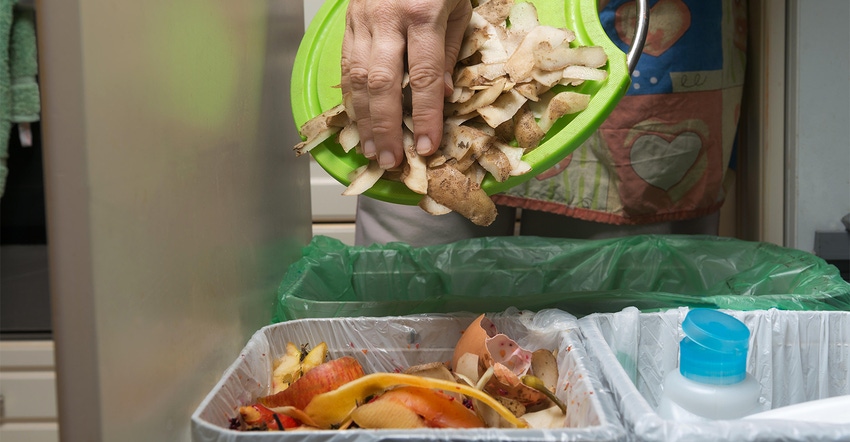What Los Angeles Has Learned About Curbside Food Waste Collections
The city of Los Angeles has collected comingled organics curbside for a few years, but the initiative took a big leap in January 2023, once COVID disruptions had settled down. That’s when what started as an 18,000-customer pilot expanded to a citywide program with 750,000 households able to drop food scraps, soiled papers, and yard waste into their green bins.

The city of Los Angeles has collected comingled organics curbside for a few years, but the initiative took a big leap in January 2023, once COVID disruptions had settled down. That’s when what started as an 18,000-customer pilot expanded to a citywide program with 750,000 households able to drop food scraps, soiled papers, and yard waste into their green bins. All totaled, about 1,700 tons of organics are captured each day from participating single-family and some multi-unit account holders.
The weekly service comes with no additional cost to LA Sanitation and Environment (LASAN) customers, though the agency has incurred an increase of about $60 per ton to cover transporting loads to transfer stations then on to compost facilities, and distribution of free pails with decals showing what can go in the bin. The agency contracts with Waste Management, Recology, and Athens and has added facilities to take on the extra load.
Haulers had to adjust to new delivery routes and operations with the addition of new transfer operations.
“Drivers provide feedback and work with the facilities to identify any challenges or specific logistics needed to accommodate our crew. Overall, it was a smooth transition with our planning, operations, and facilities,” says James Roska, acting environmental engineer, LASAN.
Consumer outreach and education have been key to keeping costs down and to tackling a universal challenge: shrinking the contamination rate of a difficult stream. Today in LA the program is seeing a contamination rate of around 5% to 15%.
Angelenos have learned how and why to divert through print mailers; social media and online platforms that post videos and images; messaging at local events; LASAN yard open houses; backyard composting workshops; and community clean-ups.
Drivers and ambassadors do inspections. And other efforts to double down on contamination includes prohibiting plastic bags, as well as materials labeled as compostable unless LASAN has verified them as suitable for the program, based on feedback from its commercial compost partners.
While single-family residential participation is automatic, multifamily and commercial engagement isn’t, which impacts tonnage collected, Roska says.
LASAN partners with local nonprofit LA Compost to pick up some of the slack via food scrap drop-off locations.
On average LA Compost collects over 150,000 pounds of organic material monthly from Angelenos across compost hubs and farmers’ markets in its LA City network. The service is free and participants who bring their food scraps to the farmers’ markets get a complimentary bag of compost.
“We provide composting access and education to residents because we believe in the power of choice and recognize that it will take many diverse approaches to reach our city and state waste diversion goals,” says Michael Martinez, founder and executive director, LA Compost.
The organization’s grass roots approach has been a draw for residents.
“LA Compost offers Angelenos the chance to meet and build a community with one another and to engage with composters that they can learn from and share resources with. They learn about the composting process itself and engage firsthand with the full cycle of food from plate, to ‘waste,’ and back to the soil in the form of compost,” Martinez says.
People who bring in their food scraps can scan a QR code to generate a summary of their total drop-off metrics for the year, as well as a snapshot of their collective environmental impact.
Residents have responded well to the written outreach materials and the collection pails with the explanatory decals.
Visual guidance in particular seems to be working since there are very few questions about what is allowed in the bin, Roska surmises. But staff are providing participants with written guidance to understand terminology like ‘compostables’ and biodegradables,’ as many products labeled as such often do not break down at composting facilities.
SB-1383, mandating 75% diversion of organics from California landfills by 2025, has been an impetus for the state’s jurisdictions to establish residential access to composting programs. Though the trend is catching on elsewhere. In 2022, at least 30 communities outside of California increased their citizens’ access to composting.
In 2021, at least 37 towns, cities, and counties across 19 states increased residential access to composting programs for food scraps, and in some cases, compostable packaging.
Just in the past month more headlines tell of curbside food scrap programs on the verge of rolling out, including in Queens this fall with the remaining four New York City Boroughs slated to follow suit by the end of 2024. Officials in Middle Tennessee say they will launch a year-long, curbside food scrap collection pilot before the end of 2023.
Olga Kachook, director of the Sustainable Packaging Coalition, calls food waste recycling one of the most promising and powerful tools for collective climate-action.
The Coalition has been tracking new food waste recycling programs and composting facilities as they come online and notes progress in communities of all sizes starting with waste management companies and municipalities working together to open up more opportunity.
“These programs often start small, accepting material for drop-off only but typically are the beginning of a predictable pattern towards scale,” Kachook says.
“Resident participation in early, voluntary compost drop-off and privately-run curbside collection programs [provide] strong data points and can ultimately tip the scales in favor of cities and counties offering their own municipally run, curbside collection services on par with their recycling programs,” she says.
About the Author(s)
You May Also Like




